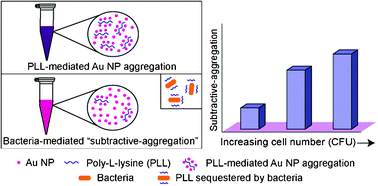In this study we report a new method for sensitive estimation of bacterial cells in solution based on a systematic decrease in the degree of poly-L-lysine (PLL)-mediated aggregation of gold nanoparticles (Au NPs). The quantification of cells was done by interacting bacterial cell suspensions with PLL and recovering the unbound PLL fraction which was subsequently used to initiate aggregation of Au NPs. A progressive decline in nanoparticle aggregation evidenced by a reduced broadening of the surface plasmon resonance (SPR) peak of Au NPs revealed a strong correlation with increasing bacterial cell numbers. Using this method we could readily estimate both Gram-negative strains of Escherichia coliMTCC 433, Enterobacter aerogenesMTCC 2822 and Pseudomonas aeruginosaMTCC 2488 as well as Gram-positive bacteria such as Bacillus cereusMTCC 1305, Staphylococcus aureusMTCC 740 and Listeria monocytogenes Scott A. The limit of detection was as low as 10 colony forming unit (CFU) of bacterial cells. The method was specific for viable cells as heat-killed bacterial cells failed to reveal the characteristic decline in the broadening of the SPR peak of Au NPs. We also demonstrate that a centrifugal filter device could be used for rapid estimation of bacterial cells in solution based on the same principle used herein. The application potential of the method was further validated in an antimicrobial susceptibility test, wherein estimation of viable cell numbers of target bacteria Leuconostoc mesenteroidesNRRL B640 following treatment with nisin, a membrane permeabilizing cationic peptide, was on par with conventional plating. The present method of bacterial cell estimation offers a distinct advantage over other conventional methods in terms of ease of operation, rapidity, high sensitivity and quantitative detection of viable cells.

You have access to this article
 Please wait while we load your content...
Something went wrong. Try again?
Please wait while we load your content...
Something went wrong. Try again?


 Please wait while we load your content...
Please wait while we load your content...